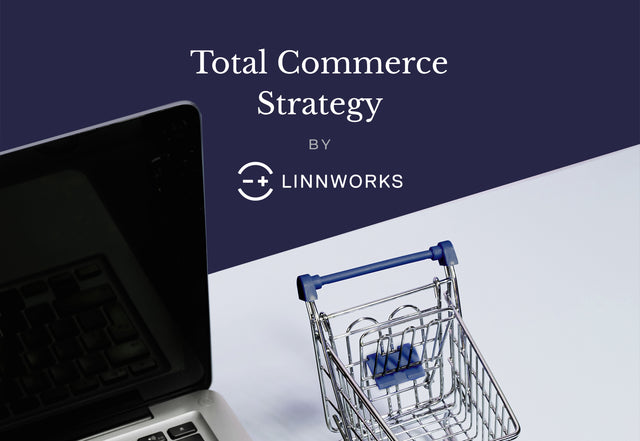Why Retailers Should Implement A Total Commerce Strategy
This guest post was written by Megan Wenzl, Content Specialist at Linnworks.
In today’s eCommerce world, retailers need to be wherever their customers may be – and that is many different places. A retail presence is no longer just confined to a physical store, a website or a combination of both.
From marketplace to mobile, social commerce to social interactions, it’s vital that retailers implement a ‘Total Commerce’ strategy that covers a much wider range of online environments and shopping behaviours, and delivers an uninterrupted experience to their customers.
But what does this mean in practice?
Total Commerce means conducting commerce wherever your customers are, on their terms.
It’s about connecting the whole of a retailer’s business and adopting a seamless eCommerce strategy that delivers a flawless customer experience – whether that’s at the point of browsing, ordering, paying or the final stage of fulfilment. It’s an as-one approach to retail that disguises the complexities of the individual components from the customer.
Retailers today need to be available to their customers on whatever channel those potential customers are using to browse at the time or upon which they prefer to shop, and the retailers need to be able to access those multiple commerce environments simultaneously.
The discovery journey has changed — it’s no longer good enough for retailers to just expect their customers to find them. Instead, retailers must work harder to find their customers and be in the right place at the right time to win the customer and the sale.
But that’s no easy task. This idea of Total Commerce requires a holistic approach to operations. And it can be a big leap for retailers who may have had a more blinkered approach to operating across channels previously, thanks to the complexity of managing multiple channels.
It requires strong visibility and management of inventory and orders, with the business operating as a single entity to satisfy this new customer demand sufficiently. Great systems are at the heart of enabling this change.
Total Commerce means conducting commerce wherever your customers are, on their terms.
Tweet this now
The Changing Customer Mindset
So what’s caused this shift? The changing habits of potential customers and the broadening scope of where they want to shop because of new shopping behaviours developed during the pandemic are two significant factors.
But consumers have also been conditioned by retailers who are best in class at managing these multiple channels. These are customers who desire convenience and ease of shopping. Indeed, convenience is a number one priority for 76% of consumers, more so than price, as 2021 eCommerce trends show based on research from Linnworks.
The more frictionless a shopping experience is, the more likely the consumer is to buy. Best in class retailers have not only realised this, but have connected and automated their commerce operations and revamped processes to deliver such a frictionless experience in abundance – and they have used the principles of Total Commerce to do this.
Of course, Amazon is undoubtedly the king of this challenge and its consideration of the customer’s desire for convenience is one reason why marketplaces are one of the top channels for consumers to shop through. 9 in 10 consumers regularly start their shopping journey on a marketplace because of the ease of the shopping experience, according to Linnworks research.
And that ease means that even though customers may intend to just start their research journey on such marketplaces, they often end up concluding the purchase there too, simply because it’s easier than clicking off site to buy elsewhere. Convenience wins again.
Marketplaces are growing fast as a result, up 80% in the final quarter of 2020, according to research from Mirakl. As well as their fast growth amongst consumers new merchants are also realising their value, with a 46% increase in the intake of new merchants last year. This means that more retailers and more of their competitors are realising the benefits of such a channel, placing a greater urgency on all retailers to adopt a marketplace presence.
And, while we may talk of marketplaces as one channel, there are multiple marketplaces beyond the market leaders of Amazon and eBay. The marketplace environment also includes specialist niche marketplaces, allowing retailers to find an even broader reach for their products.
Brands, as well as retailers, who may have started via the marketplace route are also realising the value of selling directly to consumers through the D2C route – especially since this removes the fees and margins charged by a marketplace. The D2C path also gives the brand or retailer the opportunity to build better customer data which can be used to develop closer customer relationships that ultimately will enable them to sell more.
The Opportunity Of Social Commerce
But the opportunities of Total Commerce don’t end with marketplaces and D2C.
One of the new channels for commerce is social, with social commerce expected to grow 28.4% to hit $3.3 trillion by 2028, according to Grand View Research.
Customers want to buy within their social networks, rather than being forced offsite to purchase. This means that social needs to be added to the list of channels from which consumers can buy, adding further complexity to the management of channels, stock and inventory.
A further evolution of this looks set to be livestream shopping, which combines social media with live shopping and is emerging as another way to buy that brands and retailers must consider.
Livestream shopping, which combines social media with live shopping, is emerging as another way to buy that brands and retailers must consider.
Tweet this now
The Need For Robust Connections
This growing amount of sales channels illustrates the wide range of online locations that consumers are choosing to shop. But that word ‘seamless’ rears its head again – all channels need to be connected so that the business can operate across all channels as one.
And it also means connecting the commerce operations together in a way that means the business has a scalable cost base.
The primary challenge of selling across all these multiple channels is inventory management. Retailers must manage stock across all channels, accurately reflecting stock levels across all platforms so customers aren’t disappointed by out of stocks caused by the success of a particular channel.
That means retailers need to understand inventory turnover across all the individual channels on which they are selling, to be able to manage replacement inventory effectively and not disappoint customers.
Inventory management is about the ability to have a clear view of stock levels, locations and movement of stock at all times – from supplier to the end customer. Inventory management systems can greatly simplify this process by providing this holistic view and operation, allowing retailers to concentrate on their customers.
Order management also needs to be in place to gather all a retailer’s orders quickly and efficiently, and assign them to the correct shipping services.
Retailers need to implement a system that allows scalable operations in a multichannel environment. Total Commerce enables that, helping retailers to centrally control their operations to effectively grow sales and to be ready for yet more new channels as and when they may emerge.
Total Commerce winners are those that recognise convenience is king and place their product on sale on the customers’ terms. These retailers create a seamless shopping experience across devices and have a visible and buyable presence in the channels in which their consumers are browsing – be that marketplace or social. They create an effortless experience that keeps their customers coming back for more.


